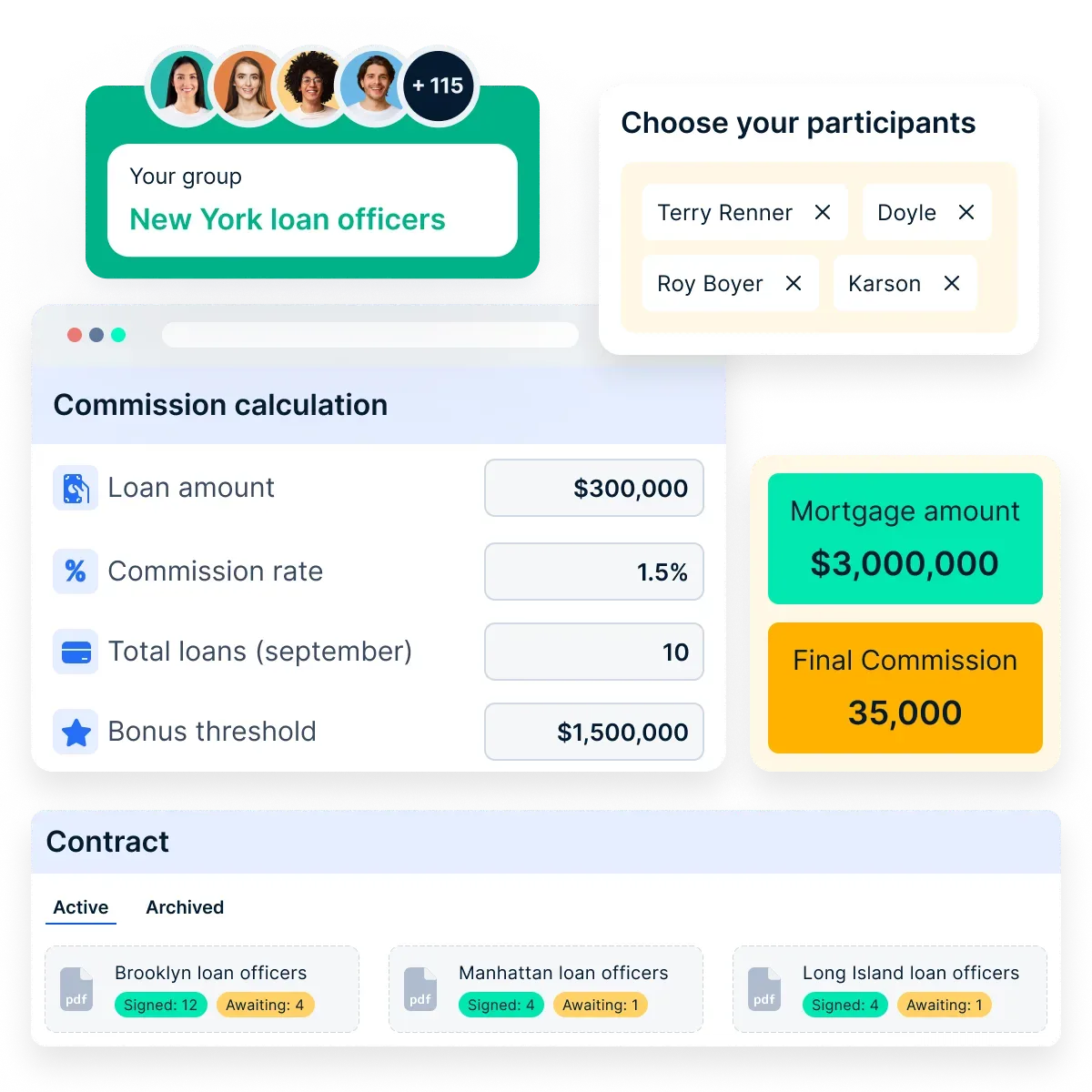The Comprehensive Guide To Enterprise Compensation Management
Explore how enterprise compensation management shapes business success. Learn strategies, avoid pitfalls, and discover how the right tools can keep top talent engaged, reduce churn, and build long-term business value in an ever-competitive market.
On this page
Enterprise compensation management (ECM) is a crucial and comprehensive business function that involves strategizing and optimizing compensation for employees, channels, and partners.
ECM is an umbrella term that encompasses creating and managing a comprehensive compensation system for an organization, covering all forms and formats of remuneration – direct and indirect, fixed and variable, as well as monetary and non-monetary.
Overseeing compensation typically constitutes a complex, time-sensitive, and demanding function in most organizations. Enterprise compensation management programs enable business owners and HR teams to maintain control and accountability over the diverse range of activities and streamline the associated components.
Modern enterprise compensation management tools also enable effective decision making and help leaders and managers keep pace with the changing dynamics of the pay landscape.
Perhaps most importantly, an effective enterprise compensation management program helps businesses crack the ‘people capital’ riddle. They let leaders design appealing salary, commission, and incentive package structures that not only pull in top talent but turn workers into motivated architects of revenue generation and organizational growth.
We cover the following in this helpful manual cum guide:
- What is enterprise compensation management?
- Why does it matter to businesses?
- How to implement one in your organization.
- Tips and best practices.
- Caveats and considerations.
Enterprise compensation management: A talent game with high stakes
This is a game every employer needs to master, since compensation, along with culture, are the two primary reasons why workers stay in an organization or why new employees join it.
A Glassdoor study reveals that salary is the most important factor candidates consider when evaluating a job offer. At the other end of the spectrum, approximately 44% of employees quit their jobs because they are not happy with what they’re earning.
A Harvard University study found that a $1 increase per hour for warehouse workers resulted in a 2.8% increase in retention.
Companies are investing in what their people want
As per a study, when organizations in the Fortune 100 Best Companies to Work For® List prioritize what their employees want, they end up more than tripling their stock market performance, by as much as 3.50 times, to be precise.
A forward-thinking company will ensure attractive packages and incentives that firmly position it in the consideration set of great talent, ahead of rivals.
An effective enterprise compensation management strategy enables them to do precisely that, with salaries, benefits, and a work environment that’s both equitable internally and competitive externally.
Defining enterprise compensation management
Enterprise compensation management is a strategic, structured, and systematic approach for designing, deploying, and maintaining the various payouts and remunerations that a business distributes across internal and external roles and functions.
Enterprise compensation management is a discipline that touches upon every element of an organization’s compensation structure, including:
- Basic pay
- Variable pay
- Perks and benefits
- Commissions and bonuses
- Special incentives
- Rewards and recognition programs
The best enterprise compensation management systems align with business goals, market conditions, and regulatory landscapes to achieve significant advantages for the business. They evolve with the business, keeping pace with changing dynamics and new opportunities.
In a nutshell, enterprise compensation management involves:
- Planning remuneration policies
- Setting pay scales, incentive brackets, and benefits packages
- Designing rewards and recognition initiatives
- Staying competitive while keeping costs under control
Advantages of an enterprise compensation management system
A ManpowerGroup study shows 75% of employers are struggling to fill their job vacancies. As per another poll from Employ Inc, 81% of recruitment professionals find it challenging to find talent.
In a climate where companies are actively engaged in a war for talent, enterprise compensation management rises far above its standard description as a payroll function, assuming the avatar of a strategic company imperative and business edge.
A weapon to win the talent war
Some of the big benefits an effective enterprise compensation management program drives for a business are:
- Links worker behaviour to business KPIs and goals, guiding organizational activities in the right direction, and driving success.
- Establishes and articulates the worth of an individual to the company by clearly linking ability, contribution, and impact to compensation.
- Sets clear expectations and career growth paths to help workers prioritize the right actions, which drives superior levels of performance.
- Builds market competitiveness for the business by attracting and retaining top talent. This is achieved through a reputation as a workplace that values its employees, offers excellent compensation and a work-life balance, empowers workers in their pursuit of self-betterment, and is generous with rewards and recognition.
- Builds a culture of equity, opportunity, and trust by basing compensation decisions and benchmarks on competency, responsibility and market metrics – as opposed to personal judgments and subjective bias – which ensures a fair and level ground, forestalls discrimination and boosts positivity and morale.
- Reinforces organizational ethos and values through intent validation and recognition mechanisms.
- Saves costs of mismanaged compensation with built-in controls automated to enforce adherence to guidelines, flag discrepancies as they happen, and adjust and re-route workflows to ensure appropriate approvals and compliances.
- Optimizes compensation-related budgets and spending with better forecasting, planning, and allocation, ensuring overall financial health for the business.
- Enables quick adjustments and agile response to external and internal environmental flux, thanks to a structured framework and modern tools that enable close controls and precision maneuvering.
- Allows leaders to judge the effectiveness of their employee compensation strategies and evaluate the ROI of payout and recognition-related investments.
- Aligns and unites functions across leadership, HR, finance, and others on a common platform and a shared source of truth, providing the visibility and transparency required for consultative planning.
- As a corollary to the above, ECM centralizes various compensation-related information and systems, including employee profiles, pay-for-performance metrics, and others, in one destination to eliminate the chaos of multi-level record-keeping. This eases daily tasks, reduces the risk of discrepancies and duplication, and enhances the overall efficiency of the organization’s enterprise compensation management program.
- Ensures an approach to enterprise compensation management that’s elastic, responsive, and ready to scale.
- Builds audit-ready workflows.
- Ensures compliance with laws, regulations, and other obligations related to compensation.
Key cogs and considerations for planning an effective enterprise compensation management program
Here are the best practices and principles for planning an effective enterprise compensation management program across all industries.
1. Data-driven strategy
Granular, relevant, and constantly updated data is the backbone of an effective enterprise compensation management strategy. Leaders must inform themselves with insights and intelligence drawn from industry and role-specific surveys, as well as both primary (direct interaction with audiences) and secondary (online) research.
There must be an audit of current strengths and weaknesses, an examination of market trends and patterns, and an awareness of competitor benchmarks.
2. Comprehensive mapping of performance to compensation
An effective enterprise compensation management strategy must establish a comprehensive, quantifiable, and unambiguous connection between effort and reward. This includes:
Performance measurement methodologies
- Goal setting
- Cascading individual and team objectives – Higher-level targets broken down into smaller, more transparent, and actionable nuggets
- Balanced scorecard metrics accommodate both financial and non-financial angles for a holistic evaluation of performance
- Performance monitoring
- Development and training
- Strategic and continuous feedback
- Rewards and recognition
Pay for performance models
- Merit matrix or grid informed remuneration increments mapped to pay level, performance ratings, and other indicators
- Threshold or tier-based, performance-influenced remuneration structures that are linked to goal attainment
- Variable bonus-like pay that may be unpredictable and discretionary
- Incentive-based pay that includes non-monetary perks, gestures, and experiences
- Rewards and recognition
3. Strategy and intent-driven ‘new age’ compensation teams
As enterprise compensation management evolves into a core business edge, the team behind it needs to rise to the occasion as well and fill more demanding shoes.
Modern-day compensation professionals must relentlessly equip themselves with new skill sets and competencies, and be ready to take on challenges and expectations that may not have a precedent. They have to remember that they are no longer just administrative service providers.
For the business, they are also data-smart insight generators, value-multiplying forecasters, and strategic decision drivers.
4. Fairness and transparency
It is vital to create transparent and fair performance KPIs that are unambiguous, built on rational premises, facilitate 360-degree evaluation of a worker’s involvement and impact, and are dynamically designed in consultation with teams to integrate on-ground realities while bolstering trust and engagement.
As a fairness and equity KPI, diversity and inclusion, spanning equal opportunity across gender, background, and age, deserves special mention.
Consult with legal professionals and urge a second opinion from domain experts to verify if your enterprise compensation management mechanisms are as balanced and impartial as you think they are.
Finally, ensure that rewards and recognition are commensurate with contributions, aligned with industry standards, offer employees flexibility in their choice, and are distributed promptly.
Did you know that Xoxoday lets you keep employees, channels, and other contributors with the world’s largest rewards platform, featuring over 10 million+ choices across 175+ countries? To learn more, book a demo now!
5. Flexibility and customization
Compensation environments and urgencies exist in a state of constant flux. Externally, market benchmarks, competitor strategies, and compliance regulations change over time. Within the company, the nuts and bolts of business goals, team mix, quotas, and pay metrics don’t remain the same.
An intuitive enterprise compensation management methodology will prioritize factors like market pulse tracking, dynamic budgets, and agile decision frameworks to take these evolving variances in stride.
6. Sync with HR policies and systems
Whichever enterprise compensation management style a business chooses to adopt, it must be in seamless sync with payroll and HRIS (Human Resource Information Systems) for data integrity, accuracy, and consistency.
Most enterprise compensation management software and applications come pre-fitted with this feature.
7. Data security
Employee salaries and channel incentives represent sensitive data for both employers and employees. For employers, this information is part of their competitive strategy against rivals, and any compromise in data security could cause significant harm, whether financially or through damage to their reputation in talent communities.
Enterprise compensation management must therefore prioritize data security, confidentiality, and privacy as top mandates to boost confidence among its ecosystem actors.
Most enterprise compensation management software and platforms employ robust security and encryption measures to control access, detect breaches, and stay compliant with data privacy laws.
8. Compliance
Enterprise compensation management software and systems come factory-fitted with compliance features and functionalities. They are programmed to comply with labor and pay transparency laws, capture industry signals in an agile mode, stay on top of changes in the legal landscape, remain mindful of broader ethical considerations (that venture beyond merely ticking statutory obligation boxes), and share compliance reports regularly with leadership.
The primary goal is to keep leaders and stakeholders aligned and informed, hedge the organization against legal risks, ensure documentation readiness during audits and annual disclosures, and foster a transparent and fair culture that sets a good example for the entire industry.
9. Communication
Communicating the essence and key elements of your enterprise's compensation management policy to stakeholders and employees is essential for evoking high levels of trust and morale.
Not everyone is comfortable decoding jargon and technicalese, and explaining the various features and nuances with helpful intent and in simple lingo can help clear the air, pre-empt misunderstanding, and encourage spontaneous and organization-wide patronage of the program.
Educate them on the benefits, encourage conversations to curate user reaction, and offer helpful resources, along with ongoing support, to help them get the best out of the program.
10. Change management
You have recently implemented a brand-new enterprise compensation management strategy. It looks great on paper, but the response so far has been lukewarm.
There have also been some murmurs from HR – something about the system being “too complicated”. So what went wrong? Nothing, in all probability.
Plan for early pushback, and be prepared to collect raw feedback. Identify, recognize, and reward quick adopters to build advocates within the organizational rank and file, set the right precedent, and flywheel trust.
11. Technology integration
With its overlap between two massive and foundational business domains—commerce and psychology—enterprise compensation management spans a vast and complex terrain. Business planners and people leaders must therefore be mindful of an entire bunch of urgencies and ambiguities, such as:
- Pay structure variance
- Workforce diversity
- Data management
- Competitor moves
- Work unions
- Compliances
- Budgets
- Complex approval processes
- Frictionless tech integration
Here is a sensitive, high stakes exercise involving a million moving parts, and carrying little room for error. Trivial gaps and insignificant gaffes can snowball into legal suits, employee distress, dented business performance and jeopardized competitive edge.
In 2022, Google paid $118 million in settlement to female employees to settle a lawsuit around unequal pay. In 2024, Walt Disney had to fork out $43.3 million to settle claims that female workers within the organization were being underpaid.
In 2025, Mastercard agreed to pay $26 million to settle allegations of underpaying Hispanic, black, and female employees.
HR and people leaders clearly need a compass. An ally to negotiate the curves and curveballs of the jungle that modern-day compensation management can be. And technology has stepped forward to fulfil the role robustly.
Enterprise compensation management software and platforms are helping HR departments and entrepreneurs make difficult pay-related decisions with never-before confidence.
AI-powered tech stacks and tools are helping them paddle past the burden of spreadsheets and clunky legacy systems with systems purpose-built for convenience, predictability, and accountability.
While a typical enterprise compensation management software is primarily designed for HR professionals, by adjusting security and permissions settings, it can also be used by supervisors, managers, and leaders from other roles and hierarchies.
Technology – notably the modern generation of enterprise compensation management software - is ushering in transformational impact for custodians of enterprise compensation by…
- Bringing greater accuracy to performance evaluation and compensation calculations, particularly for roles with complex KPIs, hybrid engagement formats, and variable pay packages, via interactive worksheets and built-in modeling tools that provide formula-driven guidelines for smart analysis and intuitive calculations.
- Standardization and automation of everyday work cadence. This includes calculations, reporting, requisitions, requests, reviews and approvals. Pre-set permission authentication and version control is effectively removes reliance on lengthy email chains and laborious paper-based approvals. The upshot is major and multidimensional: Far fewer errors, smoother processes, cracked bottlenecks, shrunken delays and boosted efficiencies. Not just that. Automation is also freeing up people leaders for higher-value tasks.By using AI to automate everyday tasks related to employee compensation, IBM’s Watson AI has managed to drive a substantial (30%) reduction in administrative costs.
- Enabling smarter choices and competitive approaches with decision support tools, including interactive dashboards, data visualization, and dynamic, on-the-go reporting.
- Ensuring competitive benchmarking vis-à-vis external markets through data analytics.
- Ensuring data integrity and privacy through effective data governance with the help of ownership covenants, quality benchmarks, and validation protocols.
- Encouraging participative and democratic access to compensation information infrastructure via digital portals and self-service (DIY) tools. This enables workers to track and manage data and decisions related to their compensation in real-time, engage directly with HR on requests and queries, and take greater control over their compensation-related needs. Along with empowering employees and instilling a sense of fairness, this also relieves HR teams of admin burden.
- Optimizing costs by eliminating mismanagement and human error.
- Saving time with shorter compensation planning cycles.
- Further reducing delays and time lags by minimizing HR touchpoints and interventions.
The above factors are driving productivity, building a positive culture, and helping to reinforce loyalty and goodwill among talent communities for organizations.
AI: Taking tech to the next
Artificial Intelligence, machine learning, and natural language processing has been steadily taking enterprise compensation management to the next level.
Through dynamic features like scenario modelling and pay comparison, real-time market data parsing, integration of historical information, pattern recognition, predictive analytics, and smart recommendations, these emerging technologies have been upending fundamental aspects like incentive personalization, compensation benchmarking (vis-à-vis region, competitor and industry), bias removal, employee experience and budget optimization.
According to a report by Deloitte, organizations that leverage AI in their enterprise compensation management initiatives can expect to see up to a 12% increase in employee retention rates. The lesson? The right tech, in tandem with experience, can drive extraordinary results.
There are more examples.
Weaving AI into enterprise compensation management processes has helped organizations reduce administrative time by 40%, as per a Gartner finding.
Salesforce has reduced time spent on compensation planning by a good 30% by implementing AI-powered analytics.
Pharma major AstraZeneca experienced a 25% increase in employee satisfaction (which encompassed better utilization of benefits by workers, an important KPI for measuring success) by turning to AI-driven platforms for managing employee benefits.
Not surprisingly, a survey by Deloitte shows 77% of organizations are actively investing in HR technology.
Xoxoday Compass: An enterprise compensation management software purpose-built for simplicity and impact
Xoxoday Compass, the world’s leading enterprise compensation management software powered by AI, lowers the entry barrier for organizations looking to upgrade to the technology bandwagon with a low-code and no-hassle framework.
With Compass, business leaders and HR teams can streamline the setup, management, and maintenance of their payout, incentives, and rewards plans effortlessly.

Compass is designed to help businesses of all shapes, sizes, and industries taste the transformational benefits of a truly customizable, scalable, and secure enterprise compensation management software that global leaders like AT&T, Coca-Cola, and Mercedes-Benz trust.
How to implement a high-performance enterprise compensation management program in your organization?
Here’s an outline of the key steps and inventions.
- Start with good data – don’t shirk the homework, do the research
- Mesh external factors with internal priorities to build a single, cogent, and connected roadmap
- Customize a performance–compensation matrix that optimally maps effort and reward
- Articulate the architecture
- Define the policies and procedures
- Customize a ‘total rewards’ mindset and framework in the context of your organization
- Establish pay ranges
- Outline time horizons for probation, promotion, and similar
- Clarify progression criteria and recognition eligibility
- Benchmark KPIs competitively by considering what top industry players are doing
- Establish communication bridges with stakeholders to stoke engagement and adoption
- Deploy the right tech stacks and platforms that can help track, shepherd, and augment outcomes
- Actively monitor the impact, integrate listening and feedback mechanisms, and continuously apply learnings
- Bake in mechanisms for agile edits and changes on the go
- Not least, educate leaders and train managers on the rationale and stipulations that inform the compensation strategy, procedures, and mechanisms involved, as well as the nuances of a ‘total rewards’ driven approach.
How to measure the success of your enterprise compensation management initiative?
To ensure your enterprise compensation management program is both holistic and individualized, you must cover a broad base and evaluate it from multiple angles.
Let us take a look at the key ones.
Business impact indicators
- Revenue generated per employee
- Cost incurred per employee
- Employee contributed to enhancements in profit margins and market share
- Overall program ROI
- Total cost of program ownership - including licensing, deployment, and maintenance-related expenses - and assessment of ROI.
Candidate and talent indicators
- Offer acceptance rates
- Employee ratings and reviews
- Employee turnover or churn rate
Efficiency and process indicators
- Cycle time of compensation-related activities and operations
- Administrative resource utilization and cost per employee
- Error rates in processing
- Manager's satisfaction with systems and tools
- Adherence to legal regulations and relevant laws
Employee experience indicators
- Clarity on compensation policy and programs
- Frequency of engagement
- Benefits utilization rate
- Perceived fairness ratings
- Overall satisfaction scores
Challenges involved in deploying enterprise compensation management programs in business
The larger the business, the more challenging it becomes to ensure fair, timely, and compliant compensation. Here's what makes large-scale deployments tricky.
1. Variance and ambiguity management
The landscape of compensation is far from static or consistent. People and HR leaders must contend with fluctuations across various geographies, cultures, roles, and other parameters on a daily basis.
One viable workaround to this challenge is to develop globally harmonized compensation architectures and centralized governance frameworks. These must be deployed in a decentralized manner and flexibly adapted to local conditions.
Then, of course, there is the matter of measuring an employee’s impact on overall organizational outcomes. This can be a particularly knotty ask when it comes to quantifying intangible skills or isolating individual contributions in a group setting.
2. High costs
As per the U.S. Bureau of Labor Statistics, compensation costs account for about 70% of a company’s overall operating expenses. Add the extra bill of maintaining a program to manage it, and the hole in the company coffers becomes larger.
Way out? Conduct revenue and ROI forecasting to evaluate the financial viability of an enterprise compensation management intervention in the organization, and consider adjusting goals within budget constraints to pull it off.
3. Bias and subjectivity
People ultimately make compensation decisions and, therefore, are not immune to cognitive and human bias. In fact, pay disparity is a common challenge faced by organizations worldwide.
To combat it, implement clear compensation policies that are shared organization-wide, visible pay brackets with rational supporting arguments, unconscious bias training for team members, and feedback-driven evaluation.
4. Expectations to deliver
Planned change is often accompanied by high expectations. Both employees and supervisors will look to your shiny new enterprise compensation management initiative to solve their little and big problems overnight, and usher in life-altering experiences from day one.
And when that doesn’t happen, most programs take time to get set – the disappointment can spill over into impatience, stress, grievance, dampened morale, and even dented productivity.
Adopt an empathetic stance, take employees into confidence by sharing the reasons why you think results will take time (and why that’s fine), and try to be a source of moral and practical support during this time of confusion.
5. Resistance to change
Compensation is a personal and sensitive issue; an area where most of us prefer familiar practices and predictable procedures. It is natural for a system overhaul to breed confusion, misunderstanding, and fissures in trust. Not everyone is tech-savvy, and modern tools can initially be intimidating to many.
Tutorials, skill training, and candid messaging about the advantages of migrating to the ‘new way’ can help ease the crossover. Remember to tell them why before you show them how.
A proven approach is to bridge early adopters with the rest of the team. The former will relish the opportunity to demonstrate value through in-the-moment handholding that sways sentiment and quickens the diffusion process.
Level up your company’s compensation management chops with a seamless and intuitive 360-degree approach with Compass.
Revolutionizing enterprise compensation management with Compass
Xoxoday Compass lets you…
- Go live with a custom-designed enterprise compensation management platform in just hours, not weeks, with predefined functions, data templates, and themes.
- Make informed compensation decisions on the fly with scenario modeling, predictive analytics, and intelligent recommendations.
- Manage geographical variance and role ambiguity with advanced data analytics tools.
- Save time by centralizing information from multiple sources.
- Reduce manual error via automation. Automation also brings down operations and auditing efforts by as much as 90%.
- Keep decision subjectivity and cognitive bias at bay with real-time access to rational, on-ground insights.
- Protect sensitive information with best-in-class security measures.
- Stay compliant by baking regulatory requirements deep into workflows and reports, as well as with industry-leading certifications and accreditations.
- Keep costs down with intelligent budget management informed by AI. Compass lets you save up to 20% on incentive expenses.
- Ensure organization-wide adoption with easy-to-use dashboards, and also by running simulation exercises before launching any new compensation structure.
- Minimize resistance to change by establishing two-way communication and engagement channels, ensuring accurate and on-time payouts, and implementing personalized reward structures.
A ‘Total Rewards’ approach that integrates multiple nuances and layers of human motivation – intrinsic, extrinsic, cash, and non-monetary.
Xoxoday Compass effortlessly integrates with all popular tech stacks and system frameworks (like ERP, CRM, HRMS, HCM, spreadsheets, and others) via native integrations.
To check it out today, book a demo.















